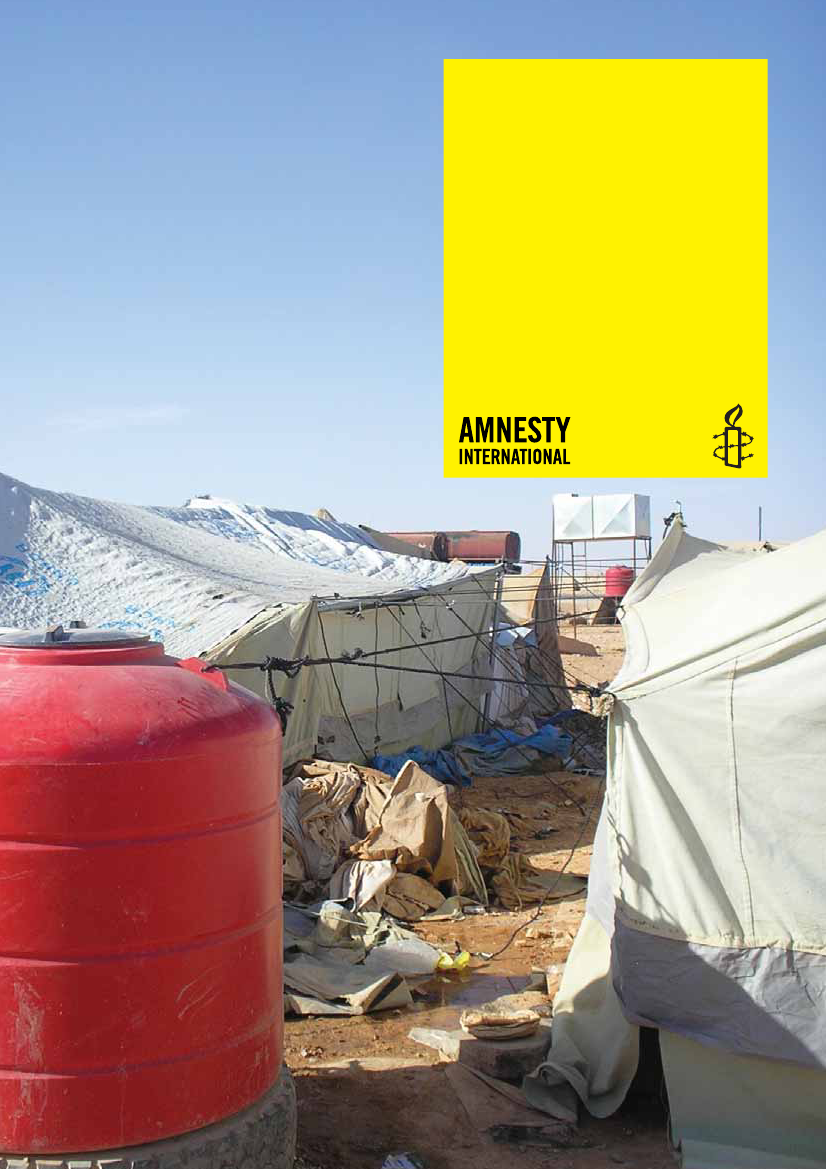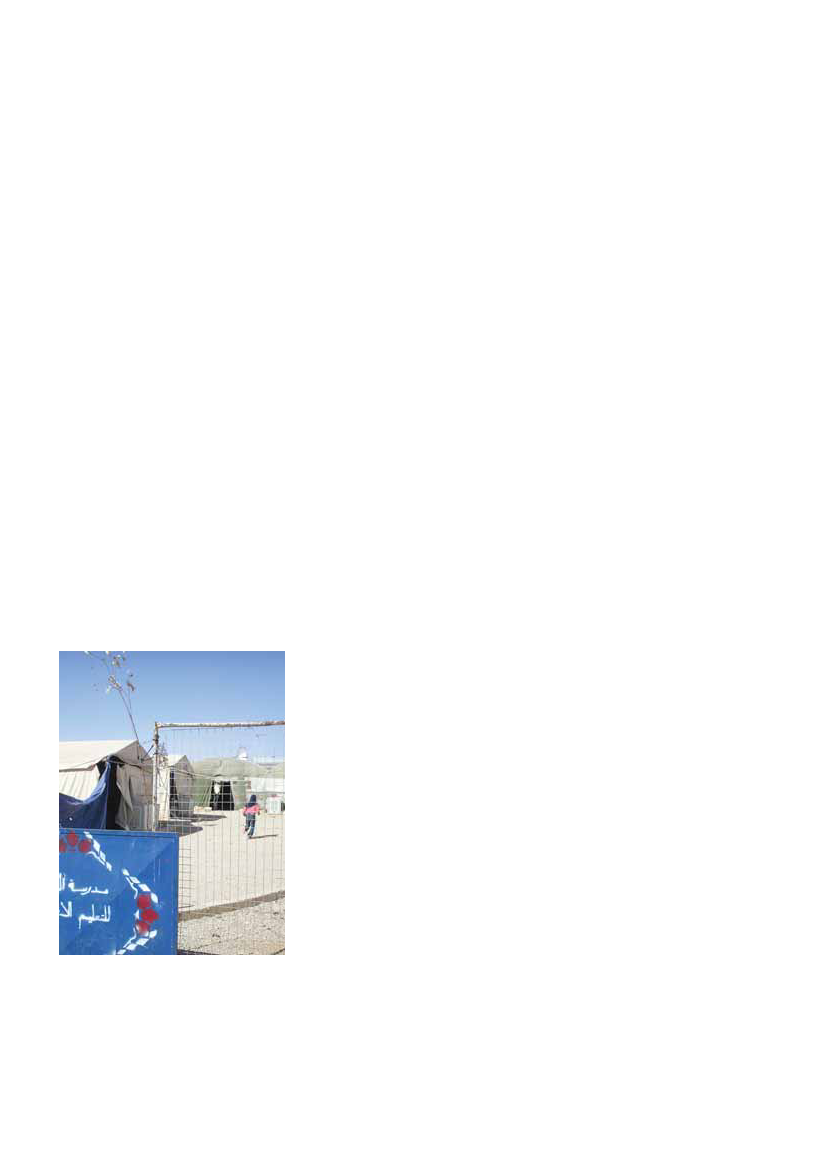Udenrigsudvalget 2007-08 (2. samling), Det Udenrigspolitiske Nævn 2007-08 (2. samling)
URU Alm.del Bilag 130, UPN Alm.del Bilag 72
Offentligt
AL-TANF CAMPTRAUMA CONTINUES FORPALESTINIANS FLEEING IRAQ
� Amnesty International
‘LIKE 10 YEARSANYWHERE ELSE’ONE DAY HERE ISA resident of al-Tanf camp talking to Amnesty International
At least 729 Palestinian refugees who have fled Iraq are stranded in appallingconditions in al-Tanf camp in the no-man’s land on the Iraq-Syria border, as of2 April 2008. The narrow strip of land, wedged between a concrete wall and themain transit road from Baghdad to Damascus, is dry and dusty. Temperaturessoar to 50oC in summer and plunge to below freezing in winter. Overcrowded tentsare the only protection from the heat, the snow and the blinding sandstorms.Danger is everywhere, especially for thechildren. The land is infested withscorpions and snakes. The school tentsare unprotected from the busy highway,which has already claimed the life of aboy knocked down by a truck. Heatingand cooking systems in the tents regularlycause fires that destroy tents – 42 tentsin all, according to residents who spoketo Amnesty International delegatesvisiting the camp in March 2008.A fire in April 2007, said to have beenstarted by a spark from an electric cable,engulfed much of the camp. Three peoplewere severely burned and 25 others,mostly children, suffered minor burnsand smoke inhalation. Many people hadtheir few possessions destroyed.An official from UNHCR, the UN refugeeagency, told Amnesty International thatit was the second major fire in the camp:“It is an example of how inappropriateand dangerous this place is for humansto live in and underlines the need tomove these refugees to an appropriateand safe place.”Despite the unsafe and harsh conditionsat al-Tanf, the population of Palestinianrefugees from Iraq in the camp is growing.The camp was initially establishedin May 2006 when a group of 389Palestinians fleeing persecution in Iraqwent to the Syrian border but wererefused entry by the Syrian authorities.The Syrian authorities have allowed in� Amnesty International
The camp’s school, which backs onto a busyhighway without protection.
April 2008AI Index: MDE 14/012/2008
� Amnesty International
Emergency food provisions arrivingfor the camp’s 700 residents.
over 1 million refugees fleeing Iraq butare generally not willing to acceptPalestinian refugees. The camp continuesto expand as some of the approximately4,000 Palestinians who used forgedpassports to enter Syria are being pickedup by Syrian security forces and deportedto the camp on an increasingly regularbasis.
UNRWA and UNICEF have establisheda school in al-Tanf, and teachers fromthe camp now educate more than 150children. However, older students forcedto quit university in Iraq are unable tocontinue with their education.Basic medical care is provided inal-Tanf, but people needing emergencytreatment are taken to the Palestinian
Red Crescent Society hospital in theSyrian capital, Damascus. Al-Tanfresidents say the size of the camp’spopulation demands full medical serviceson site. In 2007, a man died of kidneyfailure – he had initially been treatedin Damascus, but when his conditionsuddenly deteriorated the camp couldnot give him the necessary emergencycare and he died.
Access to servicesUNHCR is the main agency helpingrefugees fleeing Iraq and provides food,water and fuel to those at al-Tanf. UNHCRstaff in Syria visit the camp daily.UNRWA, the agency that has beenhelping Palestinian refugees since 1950,provides basic health, education andsocial services. Other UN agencieshave also assisted at al-Tanf, includingUNICEF, the UN Children’s Fund, whichhas set up a child-friendly space for thecamp’s children, 18 of whom were bornafter their families arrived in the campand have known no other life.
WHY PALESTINIANS ARE FLEEING IRAQPalestinian refugees in Iraq have been targeted for gross human rights abusessince the US-led invasion in March 2003. They have been threatened, abducted,tortured and killed mainly by Shi’a armed militia groups, in particular the MahdiArmy, followers of the Shi’a cleric Moqtada al-Sadr, but also by Iraqi governmentforces. The bodies of those abducted and killed are often found mutilated or withclear marks of torture. Palestinians have been targeted because of their ethnicityand because they are reputed to have received preferential treatment underthe former Ba’ath government headed by Saddam Hussain. As a result of thepersecution, thousands have fled their homes, mostly in Baghdad, after they ortheir relatives suffered abuses or received death threats. According to UNHCR,since 2003 the number of Palestinians in Iraq has fallen from 34,000 to around15,000. UNHCR considers Palestinians, especially those at al-Tanf, to be amongthe most vulnerable among the 2 million refugees who have fled Iraq.
April 2008AI Index: MDE 14/012/2008
� Amnesty International
Trauma and despairMany camp residents described toAmnesty International the horrific eventsthat prompted them to flee Iraq andhave left them traumatized. Some hadbeen kidnapped and tortured. Othershad relatives who had been abducted,mutilated and killed. Others spoke ofarmed militia cutting off ears, gougingout eyes, pouring acid over the headof captives.Mas’ud Nur al-Din al-Mahdi and ‘Adnan‘Abdallah Melham, both now living inal-Tanf, were among four Palestiniansarrested in May 2005 and detained bythe Iraqi security forces. They weretortured and paraded on television“confessing” to a bomb attack. The fourwere released in May 2006 after a courtruled that there was no evidence thatthey had been involved in bomb attacks.Mas’ud Nur al-Din al-Mahdi told AmnestyInternational that the torture he sufferedincluded being suspended upside-downfor a long time and having a large stoneput on his genitals.Members of one family now at al-Tanfdescribed to Amnesty International themurder of two of their brothers in
Baghdad – Mohammad Hussain Sadeqin March 2006, and ‘Omar HussainSadeq a year later.The people in al-Tanf are alsotraumatized by the conditions in thecamp and their fear that they may bestuck there for many more years. Oneresident pleaded with AmnestyInternational delegates to “save us fromthis hell”. He added: “A human beingdoesn’t live just to eat.” Another said:“We regret that our plight depends onpolitical decisions rather thanhumanitarian considerations.”UNHCR believes that resettlement inthird countries is the only possibledurable solution for these Palestiniansat the present time. It told AmnestyInternational that the Chileangovernment offered to resettle an initialgroup of 116 Palestinians from al-Tanf;their departure is expected in April2008. A number of other governmentsoutside the Middle East have reportedlysaid they will resettle some of al-Tanf’sresidents, but their plight is desperateand safe resettlement cannot comequickly enough.
Above:A boy playing on the edge of the camp.Front cover:The red tanks scattered aroundal-Tanf supply residents with water.
At least 2,000 Palestinian refugees fromIraq are also suffering extremely harshconditions in al-Waleed camp, anothermakeshift camp near the Syria-Iraq border.Al-Hol camp in al-Hassakah governorate innorth-east Syria is home to a further 300Palestinians from Iraq.
In October 2007 Amnesty Internationalpublished a report –Iraq: human rightsabuses against Palestinian refugees(AI Index: MDE 14/030/2007) – whichdetailed the abuses and urged theinternational community to act urgently tohelp resettle Palestinian refugees from Iraq.
ACT NOWPLEASE WRITE TO YOUR GOVERNMENT:draw its attention to the plight of Palestinian refugees in al-Tanf camp, highlightingthe need for immediate action;
April 2008AI Index: MDE 14/012/2008Amnesty InternationalInternational Secretariat, Peter Benenson House1 Easton Street, London WC1X 0DW, United Kingdomwww.amnesty.org
call for urgent assistance in resettling them and other particularly vulnerablerefugees from Iraq;call for expedited processing for resettlement in recognition of the extremely harshconditions in the camp.
Amnesty International is a global movement of 2.2 million people in more than 150 countries andterritories who campaign to end grave abuses of human rights.Our vision is for every person to enjoy all the rights enshrined in the Universal Declaration of HumanRights and other international human rights standards.We are independent of any government, political ideology, economic interest or religion – funded mainlyby our membership and public donations.




